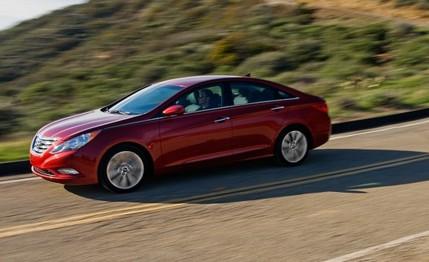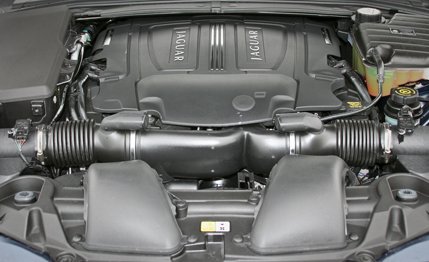
 Short Take Road Test
Short Take Road Test
Hyundai is betting big that the all-new 2011 Sonata’s striking looks will hook as many consumers as its thrifty engine and gobs of standard equipment. We called the car “impressive” on first glancing at its four-cylinder-only spec sheet and seeing it on display at last fall’s Los Angeles auto show. But we immediately wondered whether it would be as dynamically competent as it is aesthetically attractive. More on that in a minute—first, the stats and info.
The Goods


The 2011 Sonata is nearly an inch longer than the previous model, with a wheelbase stretch of 2.6 inches. The bloat brings the sedan up to the EPA’s large-car classification, alongside the Honda Accord. But weight is kept in check through the extensive use of high-strength steel, beneficial because the Sonata won’t have the V-6 option that its competitors offer but sell in relatively low numbers. The sole engine for now in all three trims (GLS, SE, and Limited) is a direct-injection 2.4-liter four-cylinder that makes 198 hp and 184 lb-ft of torque. Our SE test model’s standard dual exhaust added 2 hp and 2 lb-ft, bringing the totals to 200 hp and 186 lb-ft. A Hyundai-designed six-speed automatic is offered across the range, with the base GLS getting a standard six-speed manual. An optional direct-injection, 2.0-liter turbo-four will appease the power hungry when it launches later in the year, at which time a gas-electric hybrid will also be introduced as a range-topping model.
Weighing in at a tidy 3340 pounds, the SE hustled to 60 mph in 7.8 seconds and through the quarter-mile in 16.1 at 89 mph. No records were broken, but the times are within a few ticks of the quickest four-cylinder players in the class, the Accord and the Nissan Altima. Our sporty SE model’s skidpad grip of 0.84 g is among the best in the segment, too, but its 181-foot stopping performance from 70 mph is merely so-so.
But a family hauler like this isn’t about track numbers. What’s important is that the Sonata is responsive and predictable at the helm. The direct-injected four can be a little raucous when pushed, but it offers good thrust from low revs. There’s plenty of grunt to pull out comfortably into fast-moving traffic. The brakes are solid, with a reassuringly firm pedal, and the electrically assisted steering, although vague and a tad slow, offers decent turn-in response. The SE’s standard 18-inch wheels, V-rated Hankook all-season rubber, and sport-tuned suspension (front struts, multilink rear) provide more than enough cornering confidence to send groceries and toys flying about the cabin while still permitting a forgiving ride with minimal road noise. In addition to the standard manumatic shift gate, SE models sport paddle shifters on the steering wheel, although they’re more an affectation than anything particularly useful in everyday life. Sport seats with more-aggressive bolstering would round out the SE package nicely, but they’re not on the options list.
Fuel economy for all auto-equipped Sonatas is EPA rated at an impressive 22 mpg in the city and 35 mpg on the highway—24/35 mpg with the manual—with the highway figure being best in class. We’re anxious to drive the new Hyundai on more sedate commutes around Ann Arbor, however, as our 400-mile flog in the mountains around San Diego netted only a 24-mpg average.
Go with the Flow, Man
Called “fluidic sculpture” and looking like a Far East cousin of the Volkswagen CC—with a dash of Mercedes-Benz CLS-class thrown in for good measure—the Sonata’s sleek new design hints at styling cues that will proliferate throughout Hyundai’s lineup. The result is very striking on the road, and the Sonata looks downright beautiful parked next to the dowdy Accord. A prominent crease adds depth to the body as it dives across the car’s flanks, and a chrome strip under the windows extends all the way forward to the headlights, lending additional contrast. SE models come with the aforementioned dual exhausts and sharp-looking 18s (16s and 17s are the sizes available on GLS and Limited models), as well as a darker finish for the prominent chrome grille and stylized “H” emblem.
The glitzy, upscale theme carries over inside, too, with flowing shapes, a multitude of attractive materials, and impressive quality—forget Toyota, the Korean automaker is quickly homing in on Lexus-level fit and finish. Although the Sonata’s beltline is relatively high, visibility is good in all directions, with minimal blind spots. Combined with the nice mix of textures, the interior feels warmer and airier than the mostly dark hues suggest.
The instrument panel looks sharp and is easy to read, with digital readouts inside the analog speedometer and tach that flank a multifunctional info screen. The center stack is uncluttered, with basic single-zone climate controls (a dual-zone setup is offered on the Limited). The optional touch-screen nav system looks crisp and is intuitive to use. Complaints are few and include a steering column that felt as if it were positioned a bit low on the dash and lacked enough rake for lankier drivers. And despite a generous 61 cubic feet of space for front passengers, along with one of the largest trunks in its class at 16 cubes, the Sonata’s back seat is a bit narrow for three adults and short on headroom due to the sloping rear window. Vanity does have its drawbacks.
The Power Play
Although it’s clear Hyundai has really upped its game with the 2011 Sonata, pricing has changed little from that of the previous generation. GLS models start at a competitive $19,915 with the six-speed manual; standard features include six airbags, ABS and electronic stability control, keyless entry, power windows and locks, heated and powered mirrors, and Bluetooth connectivity. An additional grand will net you the six-speed auto. Stepping up to one like our SE tester will run $23,315 to start and just over $26,000 with the optional Navigation and Sunroof package, which is the only major option. This combination suited us well, but sadly, it cannot be configured with heated leather seats. For that luxury, you must spend at least $26,015 for the Limited model, which also comes with dual-zone climate control, auto-dimming mirrors, vents for rear-seat passengers, and other unique, upscale bits. A $2100 Navigation package adds touch-screen nav, a rearview camera, and a premium Infinity audio system, bringing a loaded Sonata to just over $28,000.
Factoring in the attractive pricing, we find it’s hard to fault the new Sonata on a major level. It does everything well save for ultimate driving thrills, and it’s mega-stylish. However, the Sonata still needs to prove itself in the market—the mainstream sedan segment in which it resides is hotly contested, with sales measured in the hundreds of thousands. We’re eager to stack this car up directly against the 10Best-winning Honda Accord to see if the Hyundai’s newfound goodness is enough to topple the king from its comparison-test throne. But you can still color us very impressed, no matter what.